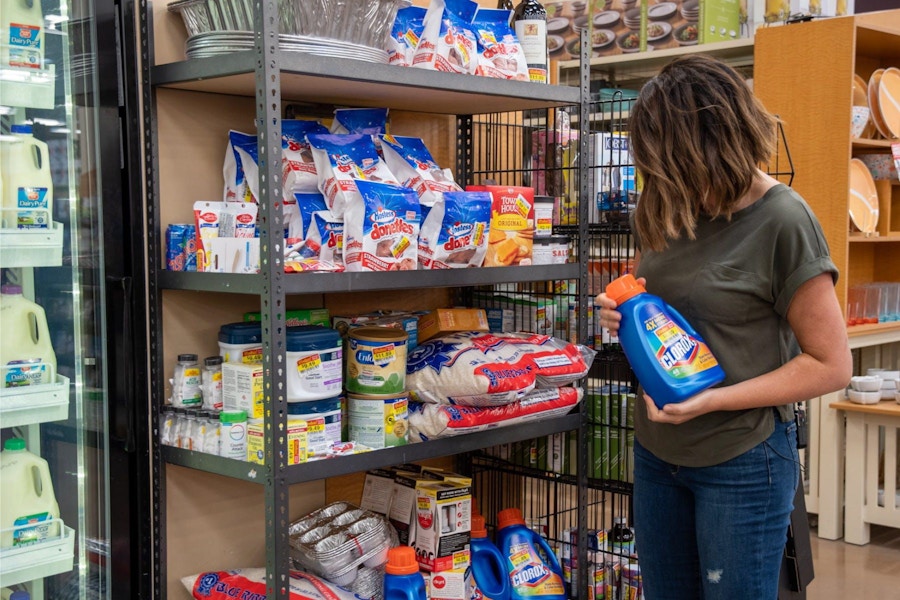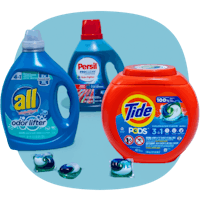Money — we work hard for it, and we’d really like it to work hard for us. Stretching a hard-earned dollar when everything seems to cost so much can feel challenging. But frugal living isn’t just about spending less; it’s about spending smart.
If you’re feeling the financial squeeze lately, you’re not alone. In its Wealth Watch survey, New York Life found Americans set out to save an average of $7,435.57 in 2024. The reasons for saving differed among those surveyed, with the biggies being building an emergency fund, paying off credit card debt, and saving up for a vacation.
Whatever your why for making a shift toward frugal living, there are many ways to do it beyond clipping coupons (though we’ll never turn down free money, which is essentially a coupon). Be strategic, be flexible, and most importantly, live your best life with what you have.
Download The Krazy Coupon Lady app or text HACKS to 57299 for the latest money-saving tips, deals, and coupons.
What is Frugal Living?

Frugal living isn’t simply about being cheap. It’s about being intentional, mindful, and conscious when it comes to how you spend your money. This approach doesn’t demand that you scrimp and save and sacrifice all of the things you love in order to save a buck. The goal is to cut back on spending in some areas to free up the budget in others.
Each individual’s approach is unique to their own lifestyle and goals.
What Does Frugal Living Mean?
“Frugal” and “cheap” are not interchangeable terms. On a literal level, the definitions are actually quite different. Merriam-Webster discusses “cheap” as “of inferior quality or worth.” “Frugal,” on the other hand, means “characterized by or reflecting economy in the use of resources.” In other words, cheap living might mean wanting the lowest priced item, no matter how poor the quality is. Frugal living means spending less on things that don’t really matter to you.
For example, a frugal person won’t buy the cheapest toilet paper they can find if they end up hating it, all for the sake of saving a little money. Rather, perhaps they’ll buy a cheaper brand of paper towels — something that doesn’t really make a difference to them — and spend the money necessary to buy the toilet paper that they prefer.
What Are Frugal Living Tips?
There are so many creative ways to cut corners and save money. You’re not restricted to clipping coupons! As you get started on your frugal living journey, you might find these guidelines helpful:
Do a before-and-after comparison. Before you change anything, write down what you’re currently spending on the products you regularly buy. As you swap them out for more budget-friendly options, you’ll be able to see exactly how much you’re saving. Not only is this incredibly satisfying, but it’ll help you keep track of where you are in terms of your finances and goals.
Change one thing at a time. We know that it might sound exciting to do a complete 180 and overhaul your life. But this is going to end up being overwhelming and harder to maintain.
Be open to trial and error. You might find that it’s not a big deal to buy generic toothpaste but name-brand face wash is non-negotiable. That’s okay! Frugal living is about finding what works for you.

Alright, let’s get into the fun stuff. Here are our top 49 tips for frugal living.
Frugal Living Home Tips

1. Turn Down the Thermostat
Are you blowing money on your electric bill? Turn your thermostat back by seven to 10 degrees for eight hours each day and you can save 10% on your heating and cooling bill each year.
Related: How to Save Money
2. Use LED Light Bulbs
Yes, they might be a little more expensive upfront. However, the average home can save around $225 a year in energy costs, beautifully offsetting your original investment.
3. Insulate Your Home
Poorly insulated homes might be spending an extra $2,000 each year trying to maintain the temperature. Check around the doors and windows for a draft.
4. Let Your Clothes Air-Dry
It might cost you more than $82 a year to dry your laundry. Hang your clothes up outside or even around the home to easily save some cash.
5. Use Cold Water When Possible

Using up hot water can cost more than $400 a year. Check the temperature settings on your washing machine to see if there’s a “warm” option and use cold when possible. If you’re hand-washing dishes, turn the water off as you do so. And try cold showers — as an added bonus, they offer certain health benefits!
6. Change Your Air Filter Regularly

About half of your energy bill comes from your HVAC system. Replacing a dirty filter might save about 15% on your bill.
7. Use a Low-Flow Shower Head
Depending on how long your showers are, using a low-flow showerhead could save thousands of gallons of water. Imagine what that could do for your water bill.
8. Use the Dishwasher Instead of Hand-Washing

Believe it or not, the dishwasher uses less water — as many as 100 gallons a week. Routinely cleaning your dishwasherwill help ensure a greater return in savings.
9. Landscape with Care
Want to have a beautiful yard without breaking the bank? Turn your food waste into compost to save on soil, plant perennials (which can last for years) instead of annuals (which need to be replanted every year), and stick with plants that don’t require a ton of water. For an added bonus, plant leafy trees around your windows, which can help save on your AC bill.
10. Check Which Apps Are Running in the Background
Some of your smartphone apps are sucking up data (and battery life) and you might not even know it. Go into your phone’s settings to see what might be running in the background. If it’s not something you need, turn it off.
11. Make Sure Your Tires Are Properly Inflated
Deflated tires are more prone to causing trouble and can cost hundreds of dollars to replace. Plus, they increase your car’s drag and end up using more fuel.
It’ll help you be more efficient with your heating and cooling and could save you 8% on your bill, depending on the climate you live in.
12. Turn On Your Ceiling Fan
If you combine it with your air conditioning, it can help save 4% to 8%on your electric bill.
Frugal Living Shopping & Style Tips
13. Shop “New With Tags”
You might already know that you can save money by shopping for used items. But did you know that even on these websites, you can find things never worn before? Swap has a “New With Tags” filter where you can find brand-new apparel that was never worn by the original owner, and you still get it for a nice discount.
14. Look at the Price Per Unit
It’s easy to nix the paper towels on the left because you’re going to be spending way more. However, look at the cost per 100 sheets. The brand on the left is actually giving you a better deal.
15. Consider Switching to Cloth Diapers

If you have a little one at home, making this switch could mean major savings. A couple of years’ worth of disposable diapers can add up to $3,000. Cloth diapers, to compare, come out closer to $1,000.
Related: How Many Diapers Does a Baby Need?
16. Ask for the Generic Drug
Generic drugs have the same active ingredient as their name-brand counterparts. However, they’re usually 80% to 85% cheaper. Check with your healthcare provider about switching to save money.
17. Always Check for Promo Codes

Honey will search the internet to find you the best coupon codes, doing all of the heavy lifting for you. They can also notify you when there’s a price drop on an item you’ve been eyeing.
18. DIY Some of Your Regular Purchases
For example, depending on the brand, some dry shampoos will cost you upward of $25. However, you can use things right in your pantry — like cinnamon or baking soda — to achieve the same outcome.
19. Save Purchases for Big Yearly Sales
The average savings on Black Friday deals is somewhere around 24%. Clothing brands also hold sales when the seasons change to clear out old inventory. And don’t forget about anniversary sales, too. Nordstrom is big on those.
20. Fill Up Your Tank at the Right Time
Monday and Friday are when gas is the cheapest. Thursdays are the worst time to refill your tank.
21. Opt for a Balayage Over Regular Highlights/Dyeing
Balayage will grow out more naturally, which means you can spread out your salon visits and save more money.
22. Bring Your Own Cup to the Coffee Shop
Not willing to part with your Sbux addiction? We feel you. Here’s the good news: when you bring a reusable cup to Starbucks, they give you a $0.10 discount and 25 stars if you’re a rewards member. Other coffee shops offer similar deals.
23. Get a Haircut From a Student
Some research tells us that the average haircut costs $53. Instead, go to a beauty school and purchase your service from a stylist in training. For example, you can get a cut and style from the Aveda Institute for less than $20. If your family members trust you with scissors, DIY haircuts at home (even for your dog).
24. Rent Your Clothes Instead of Buying
Why spend a fortune on an outfit you might only wear once? With Rent the Runway, you can borrow clothes for a fraction of the price to buy. For instance, an Ulla Johnson dress can be yours for $470.25, or you could rent it for about a week for $75 or less.
25. Ditch Fast Fashion

We love it because it’s cheap, but it’s not the most cost-efficient. Some research says that fast fashion items are designed to last for just 10 wears. You save money up front but end up spending more to replace it sooner than you planned. Instead, spend a little more on something that’ll last you years, not months.
26. Ask for a Discount if You Pay in Cash
Some stores love this because they can avoid payment processing fees on their end. If it’s a bigger purchase, you can sweeten the deal by offering to pay in full.
27. Borrow for the Baby
Hand-me-downs are always nice, but they can really come in handy with newborns. Babies outgrow their clothes so quickly that it’s like throwing money out the window. See if you can borrow them from a friend instead. You can also try posting online in a local community group, maybe on Nextdoor or Facebook. Someone in your area might be trying to offload their baby’s old stuff.
28. Buy Convertible Gear for the Little One

There are cribs that transform into toddler beds and strollers that turn into car seats. Yes, you might pay a little extra, but it’ll probably be less than if you had purchased completely separate items.
29. Try Reusable Period Products
Consider period panties, reusable pads, or menstrual cups. They could save you thousands of dollars over the average 40 years women menstruate.
30. Shop With Manufacturers, not Retailers
The manufacturer sells to the retailer, and the retailer sells to you. So to make a profit, the retailers mark up the price. This means that if you buy straight from the manufacturer, you can save significant money. This is great for bigger purchases like furniture, although you can try it on smaller items, too.
31. Buy Gift Cards at a Discount
Buy gift cards for a slightly reduced price and save money overall. Raise makes this easy. For example, you can buy a Target gift card worth $252.39 for $249.61. It might not seem like much, but imagine making this a habit across more of your purchases.
32. Join a Gym at the End of the Month

Like a lot of businesses, many gyms have a monthly quota to meet for the number of new members they enroll. Toward the end of the month, they might be more willing to cut you a deal, but you have to ask for it! Try this approach within three days of the month’s end.
33. Subscribe & Save on Amazon
What purchases do you make regularly? Instead of buying them one at a time, use Amazon Subscribe & Save and you can save up to 15% on your purchases (and it’s less work for you, too).
Frugal Living Food Tips
34. Cut Down on Meat
One study found that by switching to a vegetarian diet, you can save about $750 a year. Even if you don’t want to go completely meatless, cutting back even one day a week can save you some cash (and a whole lot of animals, too).
35. Shop Local and in Season

Shopping local may help you save on your groceries. This is because one of the bigger expenses for the food producers is freight. If you eliminate that, the savings are passed down to the shopper.
36. Grocery Shop at the Right Times
A lot of us do our shopping on Saturdays, but you might be spending more as a result. We’ve found that beer and wine are cheapest on Mondays, while other groceries are cheapest on Sundays and Wednesdays.
37. Only Buy What You Can Eat (or Freeze)
The average household loses about $1,866 a year in food waste. If you can’t eat it while it’s fresh or save it for later, don’t buy it until you’re ready to consume it.
38. Switch to Bee’s Wrap

Ditch the disposable cling wrap and opt for reusable food wrap. You save money and reduce your waste.
39. Eat Out on Mondays and Tuesdays

Mondays and Tuesdays are the slowest days for restaurants, which often means that they run daily deals or give away extras. You get more bang for your buck.
Budgeting & Finance Tips for Frugal Living
40. Refinance (When It Makes Sense)
Refinancing basically means that you trade in your old loan for a new one with a lower interest rate. People commonly do this on their mortgages. If you can save even 1 – 2% on your interest, it’ll add up to major savings each year.
41. Use Credit Cards With a Rewards Program
With some credit cards, the bank will give you money back when you charge something. Some change the rewards monthly. For instance, for one month, you might get cash back on groceries specifically. This is an easy way to save money without really changing any of your habits.
42. Compare Your Debts

There are two main approaches to paying off debt: doing it based on the total balance (usually going after the smallest amount first) or based on the loan with the highest interest rate.
For example, you might have one loan that’s only $100 a month with a 2.8% interest rate. You might have another that’s $95 a month with a 4.25% interest rate.
In this example, you’d want to compare the savings of eliminating the higher payment/lower interest versus lower payment/higher interest. Prioritize whichever brings you the biggest savings.
43. Save on Car Insurance
Particularly if you don’t drive that much, you might benefit from car insurance based on your mileage. For example, Metromile says that you can save nearly $1,000 each year with their pay-per-mile car insurance.
44. Make One Extra Mortgage Payment Every Year
Of course, it depends on your loan balance, monthly payments, and interest rate. But even one additional payment can save you thousands of dollars in interest each year.
45. Insure Multiple Cars
If you have several cars in your family, you might be able to save money by using multi-car insurance, as opposed to insuring any of them individually.
46. Take Pictures of Your Receipts
With Fetch Rewards, you snap photos of your receipts, collect points, and redeem them for gift cards and other rewards. It’s free money.
47. Improve Your Credit Score
This is more of a long-term effort, but it can save you a lot of money. A higher credit score means that you’ll be able to secure loans with better interest rates, saving possibly thousands of dollars over the life span of the loan.
48. Put Your Money in a High-Yield Savings Account
Even if you’re not in a place to invest, a high-yield savings account can put your money to work and easily accrue 1.9% (or more) in interest.
49. Invest in an I Bond
I bonds are low-risk investments, and your money grows based on inflation — which is currently at a high.
































Tell us what you think